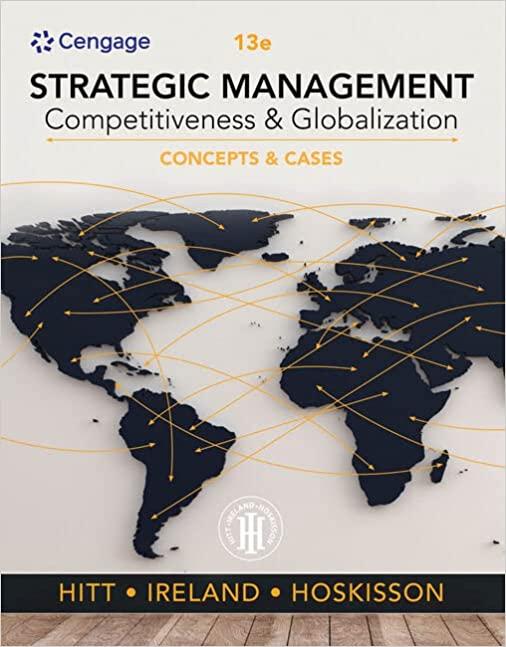Question
Principles of Management (you can use my sources below, but use APA or MLA format correctly - not weblinks. Directions. Cut and paste each of
Principles of Management (you can use my sources below, but use APA or MLA format correctly - not weblinks.
Directions. Cut and paste each of the seven questions above your response. I have given you sources below. You do not have to do research. Just read and apply the courses correctly. You must have at least one valid source for each response (so at least seven sources). Cite usingMLA or APA format.
Content Theories of Motivation:
- Discuss Maslow's Hierarchy of Needs theory in detail, providing examples for each level of the hierarchy. How do these needs influence individuals' behavior and choices in their personal and professional lives?
- Using two specific examples, analyze Herzberg's Two-Factor Theory. Highlight instances where hygiene factors and motivators have impacted organizational employee satisfaction and motivation.
- Explore Alderfer's ERG theory and illustrate how it differs from Maslow's Hierarchy of Needs. Please provide an example where individuals experienced frustration-regression in pursuit of their needs.
Process Theories of Motivation:
- Compare and contrast Vroom's Expectancy Theory and Adams' Equity Theory. Please provide an example of how employees' perceptions of effort-performance linkage and equity can affect their motivation and behavior at work.
- Explain Locke and Latham's Goal-Setting Theory. Utilize one example to demonstrate the effects of specific, challenging goals on employee motivation, performance, and satisfaction.
Recent Research on Motivation Theories:
- Describe the role of positive psychology in enhancing employee motivation and well-being. Provide two recent research examples that demonstrate the impact of interventions based on strengths, gratitude, and positive emotions.
- Explain how "nudging" from behavioral economics has been applied to motivate positive behaviors. Provide one example.
For question #3 in Content Theories- here is a very good response (do not copy but use for ideas):
Alderfer's ERG theory (Alderfer, 1969) ) is a psychological framework that builds upon Abraham Maslow's Hierarchy of Needs (Maslow, 1943). While Maslow's theory is hierarchical and suggests that individuals must satisfy lower-level needs before progressing to higher-level ones, Alderfer's ERG theory allows for simultaneously pursuing multiple needs. This response will delve into the key differences between Alderfer's ERG theory and Maslow's Hierarchy of Needs and provide examples of frustration regression in the context of these theories.
Firstly, Alderfer condenses Maslow's five hierarchical needs into three categories: Existence needs encompass physiological and safety requirements, Relatedness needs include social and interpersonal needs, and Growth needs involve self-esteem and self-actualization. Unlike Maslow's strict hierarchy, ERG theory posits that individuals can pursue needs from multiple categories simultaneously and that frustration in one category can lead to regression to the pursuit of needs in a lower category.
One significant difference between the two theories is the concept of frustration regression. According to Alderfer (1969), if an individual experiences frustration in pursuing higher-level needs (e.g., Growth needs), they may revert to seeking satisfaction of lower-level needs (e.g., Relatedness or Existence needs). This regression is a distinctive feature of ERG theory and reflects that individuals might compromise their higher-order goals if they encounter obstacles or cannot fulfill them (Robbins& Judge, 2019).
For example, consider Jon, a professional who aspires to self-actualization (a growth need) through creative expression in their "graphic arts" job. When there are no opportunities to be creative or innovative, Jon will be frustrated and may regress to seeking satisfaction in relatedness needs by forming stronger social connections with colleagues. This regression allows the individual to find fulfillment in an alternative domain when their primary pursuit encounters obstacles.
References:
Alderfer, C. P. (1969). An empirical test of a new theory of human needs. Organizational Behavior and Human Performance, 4(2), 142-175.
Maslow, A. H. (1943). A theory of human motivation. Psychological Review, 50(4), 370-396.
Robbins, S. P., & Judge, T. A. (2019). Organizational Behavior (18th ed.). Pearson.
Sources you can use for your Midterm. You must reference them and cite them correctly.
Your responses must be thorough.
https://openstax.org/books/principles-management/pages/14-4-recent-research-on-motivation-theories
(PDF) LITERATURE REVIEW ON THEORIES MOTIVATION (researchgate.net)
https://www.frontiersin.org/articles/10.3389/fpsyg.2022.845199/full
https://worldofwork.io/2019/02/alderfers-erg-theory-of-motivation/
https://link.springer.com/article/10.1007/s41042-019-00021-8
https://www.mckinsey.com/capabilities/people-and-organizational-performance/our-insights/lessons-from-the-front-line-of-corporate-nudging
https://www.mckinsey.com/capabilities/strategy-and-corporate-finance/our-insights/much-anew-about-nudging
https://behavioralpolicy.org/what-is-nudging/
https://opentext.wsu.edu/organizational-behavior/chapter/6-3-motivating-employees-through-goal-setting/
https://positivepsychology.com/motivation-theories-psychology/
https://saylordotorg.github.io/text_organizational-behavior-v1.1/s09-theories-of-motivation.html
https://www.pnas.org/doi/10.1073/pnas.2107346118
https://www.sciencedirect.com/science/article/pii/S0749597820303836
Step by Step Solution
There are 3 Steps involved in it
Step: 1

Get Instant Access to Expert-Tailored Solutions
See step-by-step solutions with expert insights and AI powered tools for academic success
Step: 2

Step: 3

Ace Your Homework with AI
Get the answers you need in no time with our AI-driven, step-by-step assistance
Get Started


